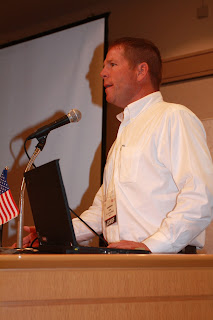SENDAI REGION (Saturday, July 13, 2013)— Packed our bags and
left the Westin Hotel, headed to Ishinomaki City, about 40 minutes away.
On the way, we passed an area hard hit by the tsunami. In this case, a major highway actually
served to protect one area, while the area on the other side closest to the
coast was virtually wiped out.
All of us have been astonished at the rapid rate of rebuilding—homes,
businesses and infrastructure.
We arrive at Ushichan Farm, a Wagyu beef feeding facility
with 600 head of high-end, black-hided Wagyu cattle. This facility purchases 600 lb. feeder calves at
auctions for about $5,000 per head and feeds them out over a two year period.
The cattle are fed about 20 pounds per day on imported
grains and rice straw, purchased from local farmers—typically on a barter basis
in return for the manure. In fact, the feeding facility is virtually
surrounded by rice fields. This company owns three feeding facilities with a
total of 2500 head.
These animals can command up to $15,000 per head at finish,
with an average of $9,000 to $10,000. Feeding costs are about $2,500—and death loss is about one
percent.
 |
| Buck Wehrbein (left) and Patrick Knobbe (right) pose with one of the managers of the Wagyu feeding facility. |
We were not allowed to walk through the sheltered barns
since our presence would disturb the animals.
The feeding system is a blend of automation and
hand-feeding. Feed is delivered to
the feed alley through automation, but is hand-fed to the animals by
employees. When cattle are
fat and ready for market, they are led by rope to the truck.
The majority of the cattle at this facility are sold to
Starzen International, a representative of which accompanied us on the tour.
Tons of Tongue
We return to Sendai City for our last meal in Japan—lunch at
Kisuke, a restaurant which features 30 different menu items—all using beef
tongue (much of it from the U.S.)
We had tongue gravy on tofu, tongue sausage, ground tongue, grilled
tongue, tongue salad—it was reminiscent of the scene in "Forrest
Gump" in which Bubba lists the various ways to prepare shrimp!
 |
| Ohgawara-san, chairman of the Sendai Beef Tongue Association and owner of the Kisuke beef tongue restaurant chain. |
The chain has 25 restaurants, serving 1,000 tongues per day
in total. Ohgawara-san, chairman
of the Sendai Beef Association and owner of the Kisuke chain, joined us for
lunch.
We are also joined by Kioshi Nagao and Miss Naomi Edo from
Soma Relief 311, another non-profit organization formed to help disaster
victims. This organization has
focused on the area of Japan affected by the disaster trifecta—earthquake,
tsunami and nuclear meltdown—with a special emphasis on assisting youth who
lost one or both parents, family members and/or friends. Leiko Shimane from USMEF has worked closely with
this group.
In the two-plus years since the disaster, Soma Relief 311
has provided summer camps for these young people including a wide variety of
outdoor activities such as camping and hiking. USMEF has provided U.S. beef and pork to feed the
campers—and continues to do so.
This will be the last year of the summer camps,
as the
organization is now looking to establish
 |
| Leiko Shimane of USMEF and Kioshi Nagao of Soma Relief 311 share a toast at lunch. |
The first such program is taking place through Portugal—and there was discussion at lunch about working together to establish a program with Nebraska to bring young Japanese to Nebraska farms and ranches for an exchange experience.
After lunch, we have about 30 minutes to shop at a Sendai
department store before heading to the Sendai airport for a short flight to
Tokyo—and a looong flight home to the U.S.
Sayonara, Nippon!



































